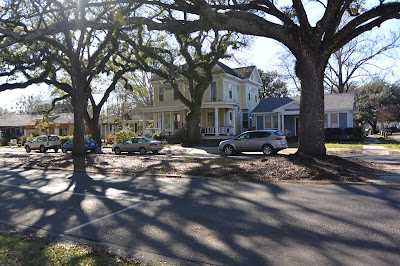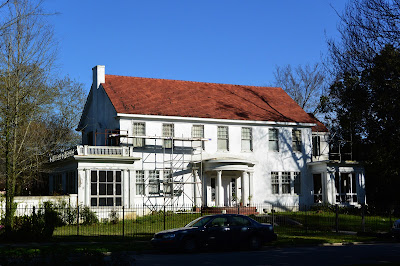 |
| At the intersection of Drehr and Wisteria; the house in the center has a bungalow porch; the one at the right is a recent 'ranch' style that tries to harmonize |
The Results of a Research Project involving
Bungalows
I.
In memoriam, H. W.
Janson 1913–1982
In the year
when, back at UC Berkeley, I was in my last year (to finish my dissertation and
get a teaching position) H. W. Janson came in the Spring semester as a visiting
professor. I audited the course
and still have my notes. But
Janson was very friendly with graduate students. Once when he invited us to his rented apartment (in our own
neighborhood, too) he had the page proofs of his new textbook, the famous History of Art (Prentice-Hall / Abrams,
NY, 1962). The first edition was
reprinted through the 1960s, and I still have mine, good as new. It was printed in West Germany and
bound in Holland. The page proofs
were quires each wrapped in two sheets of plate paper for four colorplates;
there were 79 colorplates, the 849 black-and-white illustrations being in the
text. The joint publication in
half a dozen languages (many more later) also engaged preeminently the Hirmer
Verlag (but they even had managed to get a couple of plates from Skira), and
the “trade” edition differed only by coming in a box. We had never seen such a textbook, and none of the
succeeding editions was so well sewn and well bound; their history, being
printed in various Asian nations and eventually with the availability of color
offset printing with all the illustrations in color (but none full colorplates)
is that of the death of the printer’s trade in the West, and a couple of them
tended to fall apart after a semester in a book bag. (If you want Janson, buy a 1st editon, any
printing, even ex-library, even well worn, not only for the plates and binding
but because it is what Janson himself actually wrote).
It was not long before the textbook industry and instructors
in some colleges pressed for breaking up the text into topic paragraphs with
headings, also for less demanding extended reasoning: in other words for a
typical textbook. Janson had spent
years creating a book lucid enough for a high school graduate and worth reading
by his peers, a book to educate the reader. For young people he and his wife Dora (who had also helped
on the big book, but less substantially) wrote another book. I still believe that the 1st
edition of History of Art is a
masterpiece. Succinctly but
lucidly, seemingly easily, he develops and connects ideas, always based on the
fewer than a thousand illustrations that could be allowed. It is a book to re-read many times, and
I assigned it for courses until, after his death, it was so compromised that
for a while I went back to a boxful of University Prints and offset text,
locally produced, to go with them.
All that to lead to the chapter most formative for me. Part Four, the Modern World, pp.
453–464, Neoclassicism and Romanticism, unfolds the importance of considering
them together, as the whole period c. 1750–1850, as fundamentally Romantic,
beginning as a reaction from late Baroque, from Rococo. Resorting to Nature, to Reason, to
reform, to sincerity as ideals, to embody all of this any of the existing styles
could be employed. Latrobe’s
idiosyncratic classical and neo-Gothic submissions for Baltimore Cathedral,
Monticello and the Houses of Parliament and Labrouste’s expression of honesty
in baring and managing cast iron in the Bibliothèque Ste-Geneviève, as Janson
carefully elucidates them, do belong together. And the music and literature of their time go with them, too
(Janson assumes some literacy in his students). You will have to read this for yourself. It was the modern chapters, beginning
here, that Prentice-Hall and the teaching profession had trouble with,
especially, I daresay, in producing the Teachers’ Guides, with tests provided,
that were demanded. Wasn’t the big
book a guide for the teacher? If
one disagreed with it, wouldn’t it be good to wrestle with it in discussion
sections?
For all the years when I taught the survey end to end, a
full year, I kept re-reading it and endorsing it to my students.
The other day I realized how deeply engrained it was in my
own thinking.
II.
On the other hand, the books that I bought after I came to
teach in the South, when I had more spending money but usually no teaching
assistant and much less time, did all get read, but not as I had read two
decades earlier. I used to go to
the LSU bookstore and buy the books ordered for courses that I wished I could
take. I did read the McAlesters,
but usually only used it as a Field Guide. When Barnes & Noble opened a big store here, I went and
replaced all the books that I had not recovered from lending or had given away,
and, as a new bookstore has a wonderful array of standard sets, I bought most
of the World of Art books that I didn’t have already. I did read Primitivism
and Modern Art, (the Romanticism of the last fin de siècle) but (I tend to use sales slips as bookmarks) I had
only looked at The Arts & Crafts
Movement, by Elizabeth Cumming (for England) and Wendy Kaplan (for
America). Now, in the latter, when
I went looking for something else, I found the approach that I had learned from
Janson fulfilled. I mean, Pevsner
does just architecture and loves only Voysey, and the handsome coffee-table
catalog from the Los Angeles County Museum of Art, American Arts & Crafts: Virtue in Design is all mobilier, as if architecture itself
weren’t an art and a craft, as Stickley and the whole arts and crafts movement
realized, had tended to keep my mind in a rut. From William Morris to van de Velde and Behrens and Wright
finally that whole fulfillment of sincerity in workmanship and truth in design
fell into place, that whole romance of society and its arts, the continuity of
Revolution-born art, including most (all?) of modernism. In this comprehensive picture I found a
place for all the bungalows.
For the ones that I love best are indeed the California kind
that are linked with Craftsman, but they aren’t the only ones. Also, those English cottage kinds come
from the Garden Cities like Richard Norman Shaw’s at Leyswood, and the
neo-Tudor is analogous to pre-Raphaelite renderings of pseudo-medieval tales,
not to mention Victorian fairy tales.
And so on. My hands-down
favorite Arts & Crafts house is (or was) McKim, Meade, and White’s Low
House, Bristol, Rhode Island. The
McAlesters just call it Victorian Shingle! It is not an accident that the little virtuously fireproof
house that Wright contributed to Bok’s Ladies’
Home Journal has the same rooms in a square sort of plan as that woodcraft
puzzle where you have to move the piano from one corner to the opposite one,
which also little bungalows have that aren’t the two rooms by three rooms under
a single gable, a single ridgepole.
Fireproof: that’s thinking like “green” today, and Pasadena’s Wilson touted concrete, too. And there sits the prairie-hugging
Robie House at the University of Chicago and a whole new suburb of flat-loving
Wright-influenced houses in Amsterdam.
Our Garden District can be taken as the salaried man’s equivalent. The japonoiserie
of even our 1920s bungalows is the last chapter of orientalism, and other
bungalows need not participate in it.
On the other hand, the array in Wikipedia Commons, if you go to it for
bungalows, seems to have been culled from the Realty trade. Some don’t even say what city the house
is in, and some only use the name bungalow for sentiment. Why, a couple of blocks from where I
live there’s a cinderblock box called Honeymoon Bungalow, painted in pastel
colors, and I think it may be practically a whorehouse.
 |
| On our side (the south side) of Government Street I was surprised to see a large and healthy bottlebrush tree, so common in California, rare here, in full bloom |
III.
So why keep the term
“Bungalow”?
First, though doubtless even in the suburbs of Bangalore
itself, more than a century ago, there was the easy variety of styling that
relatively expensive houses usually display; though certainly in Henry L.
Wilson’s Bungalow Book there are
houses that just look like sprawling Hollywood life style such as greeted
expatriate Europeans in the 1920s and 1930s as much as like anything in The Craftsman (and the latter itself
featured quite a variety of houses designed by Stickley’s friends, I daresay),
though most of the one-storey houses or one storey with a bedroom dormer or a
camel back in the Baton Rouge Garden District represent every variety of house
we think of as bungalows, the fact is, no matter what kind of facing they have,
they have an overall shape and character that we see and think ‘bungalow’.
So what is the McAlesters’ problem? Take the last seven lines on their p.
454 (overlooking the questionable assertion that they were inspired primarily
by Greene and Greene and admitting the importance of ‘extensive publicity in
such magazines as [most of them women’s magazines]’; thus familiarizing the
rest of the nation with the style "a flood of pattern books appeared, offering
plans for Craftsman bungalows; some even offered completely pre-cut packages of
lumber and detailing to be assembled by local labor.” How shocking!
It meant that even without adequate local resources you could build the
house you wanted. Just as Sears
offered the same kind of children’s clothes as big-town children had, and the
same kind of red wagons, and…you name it.
How shocking to build your home from a pattern book! How
shocking if you could even get an English Garden Cottage that way. ‘High-style interpretations are rare
except in California…One-story vernacular examples are often called simply
bungalows or the Bunglaloid style”. What can a Californian, like me, expect
of an author who uses a “speedometer” illiteracy like “bungaloid”?
I say that a bungalow is a vernacular concept in the first
place. That salaried Americans
like them very much. That it is OK
to like red roses (my grandparents had American Beauty red roses on trellises
in front of their house). That it
is OK also to grow up in a Council House and call it by that name, if you live
in England. After all, honesty of
many kinds was at the root of all Arts & Crafts, though the movements were
founded by and driven by the classes that had the means and leisure for
them. Ask William Morris if that
isn’t so. If America can use its
railroads and rivers and Sears and Roebuck entrepreneurial drive to ship Kit
Houses, yea, even in Colonial styles, all over the country, that is a kind of
exceptionalism that I can rejoice in.
Besides, my 85-year-old house cost very little and is still in good
condition, and I like it. I can
use its spaces as my own life style requires, a claim that “Falling Water”, for
example, cannot make.
With thanks to my
friends in Missouri.
 |
| And on Park Blvd, here is a really pretty English Cottage, across Cherokee from the Reiley-Reeves house; most of ours with such a profile and massing are Tudorized.
Go to the album for other images, and click on an image here to zoom the set.
|



































